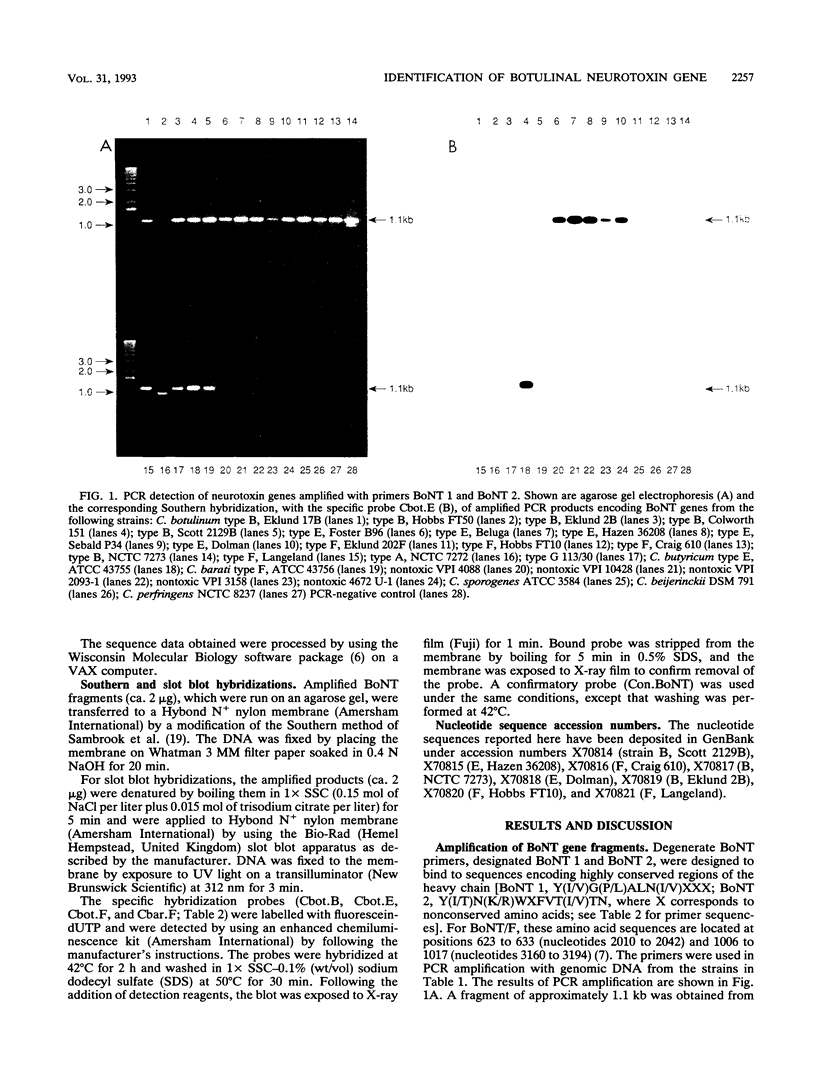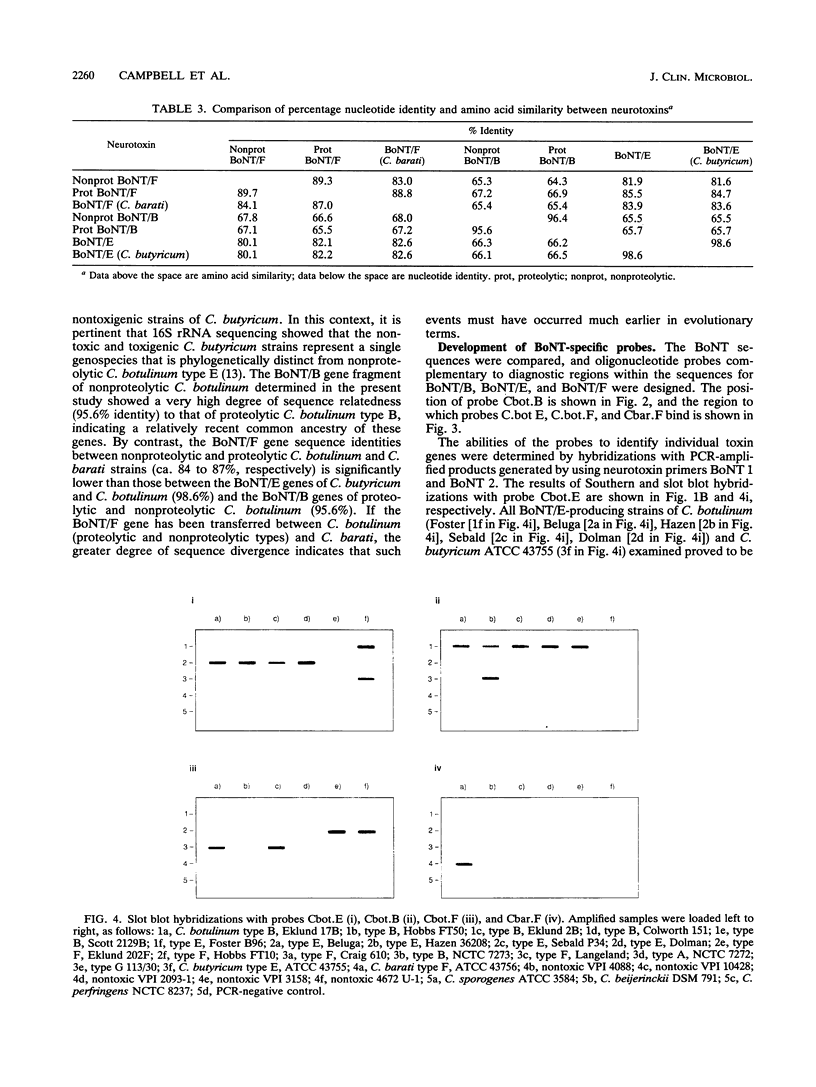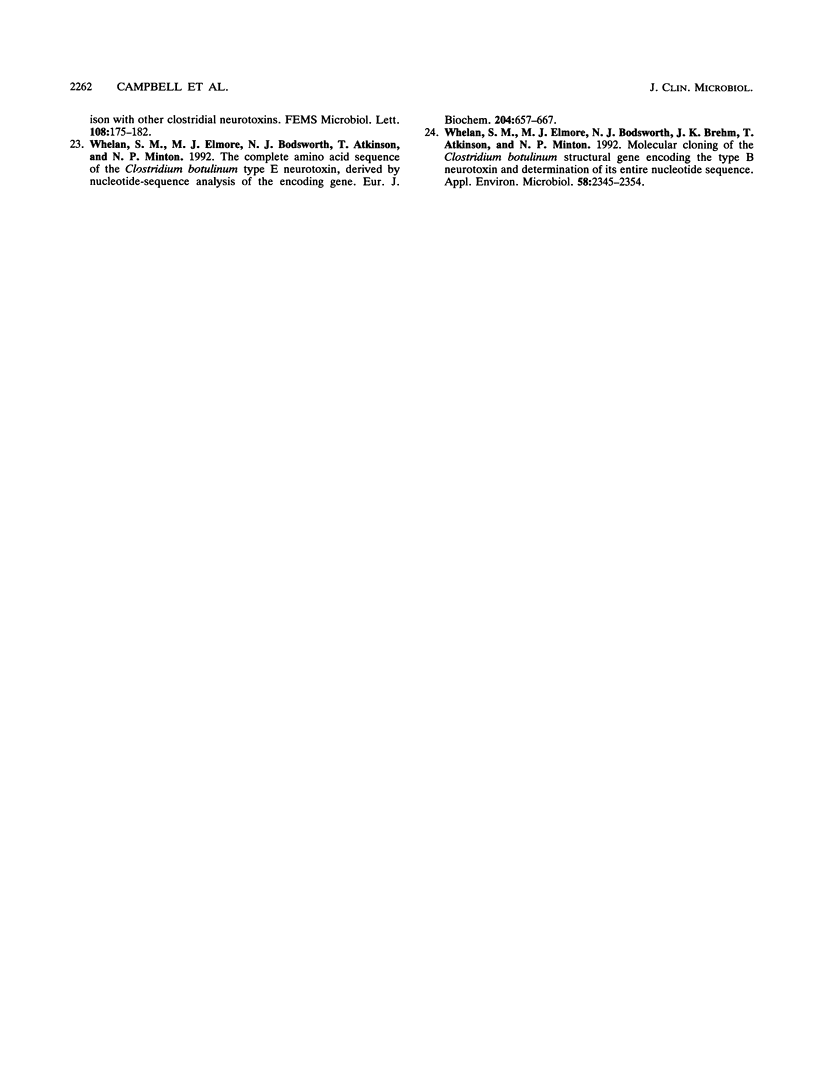Abstract
A polymerase chain reaction method was developed for the specific detection of the botulinum neurotoxin (BoNT) gene of Clostridium botulinum. Degenerate oligonucleotide primers, designed from the nucleotide sequence of the heavy chain of the BoNT gene, amplified a specific fragment of approximately 1.1 kb from strains of C. botulinum toxin types A, B, E, F, and G and neurotoxin-producing strains of Clostridium barati and Clostridium butyricum, but no fragment was obtained from nontoxigenic strains. The fragments amplified from several strains of C. botulinum types B, E, and F were cloned in Escherichia coli and their nucleotide sequences were determined. Sequences within this region were used to design oligonucleotide probes specific for BoNT type B (BoNT/B), BoNT/E, and BoNT/F genes. An additional probe was designed for the detection of the BoNT/F gene of C. barati, which differed in sequence from BoNT/F genes of both proteolytic and nonproteolytic strains of C. botulinum.
Full text
PDF







Images in this article
Selected References
These references are in PubMed. This may not be the complete list of references from this article.
- Aureli P., Fenicia L., Pasolini B., Gianfranceschi M., McCroskey L. M., Hatheway C. L. Two cases of type E infant botulism caused by neurotoxigenic Clostridium butyricum in Italy. J Infect Dis. 1986 Aug;154(2):207–211. doi: 10.1093/infdis/154.2.207. [DOI] [PubMed] [Google Scholar]
- Binz T., Kurazono H., Popoff M. R., Eklund M. W., Sakaguchi G., Kozaki S., Krieglstein K., Henschen A., Gill D. M., Niemann H. Nucleotide sequence of the gene encoding Clostridium botulinum neurotoxin type D. Nucleic Acids Res. 1990 Sep 25;18(18):5556–5556. doi: 10.1093/nar/18.18.5556. [DOI] [PMC free article] [PubMed] [Google Scholar]
- Birnboim H. C., Doly J. A rapid alkaline extraction procedure for screening recombinant plasmid DNA. Nucleic Acids Res. 1979 Nov 24;7(6):1513–1523. doi: 10.1093/nar/7.6.1513. [DOI] [PMC free article] [PubMed] [Google Scholar]
- Boroff D. A., Chu-Chen G. Radioimmunoassay for type A toxin of Clostridium botulinum. Appl Microbiol. 1973 Apr;25(4):545–549. doi: 10.1128/am.25.4.545-549.1973. [DOI] [PMC free article] [PubMed] [Google Scholar]
- Campbell K. D., East A. K., Thompson D. E., Collins M. D. Studies on the large subunit ribosomal RNA genes and intergenic spacer regions of non-proteolytic Clostridium botulinum types B, E and F. Res Microbiol. 1993 Mar-Apr;144(3):171–180. doi: 10.1016/0923-2508(93)90042-z. [DOI] [PubMed] [Google Scholar]
- Devereux J., Haeberli P., Smithies O. A comprehensive set of sequence analysis programs for the VAX. Nucleic Acids Res. 1984 Jan 11;12(1 Pt 1):387–395. doi: 10.1093/nar/12.1part1.387. [DOI] [PMC free article] [PubMed] [Google Scholar]
- East A. K., Richardson P. T., Allaway D., Collins M. D., Roberts T. A., Thompson D. E. Sequence of the gene encoding type F neurotoxin of Clostridium botulinum. FEMS Microbiol Lett. 1992 Sep 15;75(2-3):225–230. doi: 10.1016/0378-1097(92)90408-g. [DOI] [PubMed] [Google Scholar]
- Hall J. D., McCroskey L. M., Pincomb B. J., Hatheway C. L. Isolation of an organism resembling Clostridium barati which produces type F botulinal toxin from an infant with botulism. J Clin Microbiol. 1985 Apr;21(4):654–655. doi: 10.1128/jcm.21.4.654-655.1985. [DOI] [PMC free article] [PubMed] [Google Scholar]
- Hauser D., Eklund M. W., Kurazono H., Binz T., Niemann H., Gill D. M., Boquet P., Popoff M. R. Nucleotide sequence of Clostridium botulinum C1 neurotoxin. Nucleic Acids Res. 1990 Aug 25;18(16):4924–4924. doi: 10.1093/nar/18.16.4924. [DOI] [PMC free article] [PubMed] [Google Scholar]
- Hauser D., Gibert M., Boquet P., Popoff M. R. Plasmid localization of a type E botulinal neurotoxin gene homologue in toxigenic Clostridium butyricum strains, and absence of this gene in non-toxigenic C. butyricum strains. FEMS Microbiol Lett. 1992 Dec 1;78(2-3):251–255. doi: 10.1016/0378-1097(92)90035-m. [DOI] [PubMed] [Google Scholar]
- Hutson R. A., Thompson D. E., Collins M. D. Genetic interrelationships of saccharolytic Clostridium botulinum types B, E and F and related clostridia as revealed by small-subunit rRNA gene sequences. FEMS Microbiol Lett. 1993 Mar 15;108(1):103–110. doi: 10.1111/j.1574-6968.1993.tb06081.x. [DOI] [PubMed] [Google Scholar]
- Lewis G. E., Jr, Kulinski S. S., Reichard D. W., Metzger J. F. Detection of Clostridium botulinum type G toxin by enzyme-linked immunosorbent assay. Appl Environ Microbiol. 1981 Dec;42(6):1018–1022. doi: 10.1128/aem.42.6.1018-1022.1981. [DOI] [PMC free article] [PubMed] [Google Scholar]
- McCroskey L. M., Hatheway C. L., Fenicia L., Pasolini B., Aureli P. Characterization of an organism that produces type E botulinal toxin but which resembles Clostridium butyricum from the feces of an infant with type E botulism. J Clin Microbiol. 1986 Jan;23(1):201–202. doi: 10.1128/jcm.23.1.201-202.1986. [DOI] [PMC free article] [PubMed] [Google Scholar]
- McCroskey L. M., Hatheway C. L., Woodruff B. A., Greenberg J. A., Jurgenson P. Type F botulism due to neurotoxigenic Clostridium baratii from an unknown source in an adult. J Clin Microbiol. 1991 Nov;29(11):2618–2620. doi: 10.1128/jcm.29.11.2618-2620.1991. [DOI] [PMC free article] [PubMed] [Google Scholar]
- Miller C. A., Anderson A. W. Rapid detection and quantitative estimation of type A botulinum toxin by electroimmunodiffusion. Infect Immun. 1971 Aug;4(2):126–129. doi: 10.1128/iai.4.2.126-129.1971. [DOI] [PMC free article] [PubMed] [Google Scholar]
- Poulet S., Hauser D., Quanz M., Niemann H., Popoff M. R. Sequences of the botulinal neurotoxin E derived from Clostridium botulinum type E (strain Beluga) and Clostridium butyricum (strains ATCC 43181 and ATCC 43755). Biochem Biophys Res Commun. 1992 Feb 28;183(1):107–113. doi: 10.1016/0006-291x(92)91615-w. [DOI] [PubMed] [Google Scholar]
- Szabo E. A., Pemberton J. M., Desmarchelier P. M. Specific detection of Clostridium botulinum type B by using the polymerase chain reaction. Appl Environ Microbiol. 1992 Jan;58(1):418–420. doi: 10.1128/aem.58.1.418-420.1992. [DOI] [PMC free article] [PubMed] [Google Scholar]
- Thompson D. E., Brehm J. K., Oultram J. D., Swinfield T. J., Shone C. C., Atkinson T., Melling J., Minton N. P. The complete amino acid sequence of the Clostridium botulinum type A neurotoxin, deduced by nucleotide sequence analysis of the encoding gene. Eur J Biochem. 1990 Apr 20;189(1):73–81. doi: 10.1111/j.1432-1033.1990.tb15461.x. [DOI] [PubMed] [Google Scholar]
- Whelan S. M., Elmore M. J., Bodsworth N. J., Atkinson T., Minton N. P. The complete amino acid sequence of the Clostridium botulinum type-E neurotoxin, derived by nucleotide-sequence analysis of the encoding gene. Eur J Biochem. 1992 Mar 1;204(2):657–667. doi: 10.1111/j.1432-1033.1992.tb16679.x. [DOI] [PubMed] [Google Scholar]
- Whelan S. M., Elmore M. J., Bodsworth N. J., Brehm J. K., Atkinson T., Minton N. P. Molecular cloning of the Clostridium botulinum structural gene encoding the type B neurotoxin and determination of its entire nucleotide sequence. Appl Environ Microbiol. 1992 Aug;58(8):2345–2354. doi: 10.1128/aem.58.8.2345-2354.1992. [DOI] [PMC free article] [PubMed] [Google Scholar]




